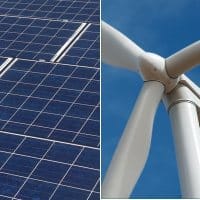Imagine a world that runs on 100 percent renewable energy – a world with zero pollution, where wind, water and solar generators provide light, heat, cooling, fuel for transportation, even for air travel.
The concept is called WWS power (Wind, Water and Solar), and research from Stanford University shows how the world currently has the technology available to achieve this future. However, policy-makers around the world must have the courage to make big changes to energy infrastructure.
“The idea is to electrify everything, thereby eliminating combustion (the burning of fuel) as a source of energy, pollution, and inefficiency,” says Mark Jacobson, professor of civil and environmental engineering at Stanford.
Jacobson’s plan relies on a holistic approach to storing and retrieving renewable energy to ensure grid stability is maintained. For example, heat from rooftop solar collectors and large solar plants would be stored deep underground and used for heating homes in winter, while excess solar electricity can be used to make ice for cooling when prices are higher.
Excess wind and solar power can produce more electricity by driving turbines in concentrated solar power (CSP) and hydropower plants, and used to drive the energy-intensive process of harvesting hydrogen from water. Hydrogen fuel cells would provide yet more storage capacity, along with powering vehicles.
Jacobson rejects scepticism from critics that renewable systems cannot meet consumer needs without fossil-fuel backup, instead arguing that current low-cost technologies can store clean energy and release it when needed to smooth peaks and troughs in demand.
“The utilities and others who are against renewables have always argued that the lights are going to go out, the grid is going to be unstable, and it will cost too much to keep a clean, renewable-energy grid stable and reliable,” Jacobson said.
“Sceptics have never studied a system of 100 percent clean, renewable energy for all purposes, and particularly one that combines low-cost storage with demand response and some hydrogen, as in this new paradigm.”
In a briefing (PDF) to the U.S House of Representatives last week, Jacobson outlined his plan for all 50 states in the U.S. and 139 nations attending the COP21 climate talks in Paris to transition to 100 percent renewable infrastructures running on WWS technologies by 2050, with an 80 percent conversion by 2030.
Doing so would, according to the study, nearly eliminate 4-7 million premature air-pollution-caused mortalities per year worldwide and 60,000-65,000 premature mortalities per year in the U.S.
An electrified world would reduce power demand by 32 percent relative to conventional fuels and save $16-20 trillion a year in global climate costs by 2050.
“There would be no need for coal, natural gas, biofuels, nuclear power or enormous battery farms for storing electricity. Such a world, which would be 100 percent clean by 2050, can result in a stable grid,” Jacobson said.
The study, authored by Jacobson and his colleague, Mark Delucchi, of the University of California, Berkeley, was published in Proceedings of the National Academy of Sciences.












































